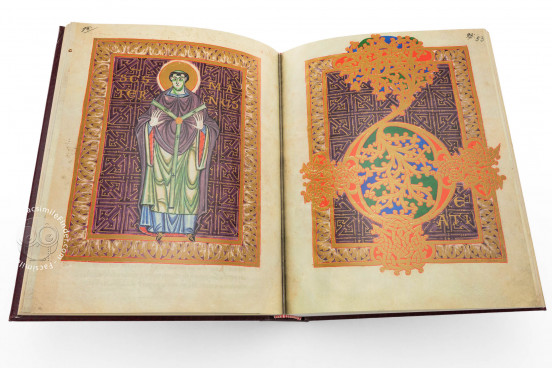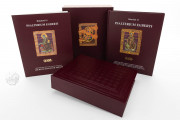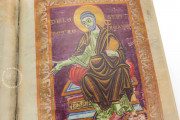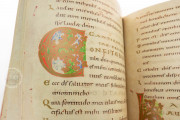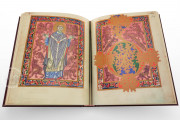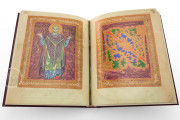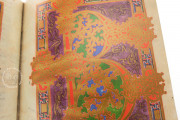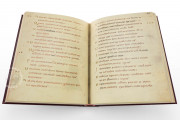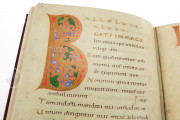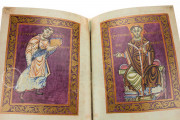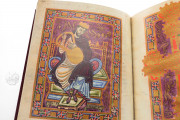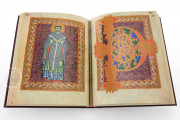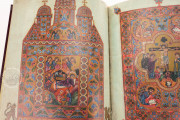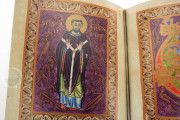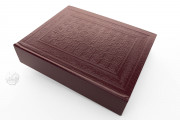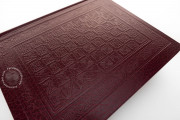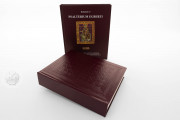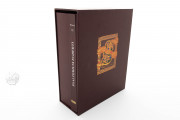The core of the Egbert Psalter is a deluxe manuscript created between 977 and 993 at Reichneau for private devotional use by Egbert, Archbishop of Trier. That manuscript of the biblical psalms, prayers, and Christian creeds opens with two pairs of facing full-page miniatures in brilliant colors with gold highlights featuring Ruodprecht (the artist), Egbert (his patron), and Saint Peter. That manuscript also features fifteen fully painted openings—dividing the psalms into groups of ten—each comprising a full-page framed miniature on the left facing a full-page crafted incipit page.
In the following century, the manuscript was amplified in Kyivan Rus for the personal use of the Polish princess, Gertruda, Consort of the Grand Duke of Kyiv. A section of prayers and five stunning miniatures in Byzantine style were added at that time.
A Succession of Bishops
The pictorial program of Egbert's psalter celebrates the founding of Trier's archbishopric in late antiquity. Egbert (d. 993) is pictured offering the book to an enthroned Saint Peter (fols. 18v-19r). The scene is presented across an opening in a pair of full-page miniatures with identical painted frames. The figures—Egbert with a square halo and Peter with a large round halo, both golden—are silhouetted against deep purple grounds. They are similarly dressed in vestments that shimmer with gold highlights.
The articulation of the psalms into fifteen sections is achieved by opening each group with a pair of pages. The first pair features the Israelite king David enthroned and playing a lyre (fol. 20v). Fourteen present a standing archbishop of Trier at the left and an incipit page dominated by a large interlace initial of gold, orange, blue, and green on the right. Patterns in gold imitating silk textiles highlight the purple backgrounds of these pages.
Enhanced for a Princess
When Egbert's manuscript came into the possession of Gertruda (1025-1108), Consort of the Grand Duke of Kyiv, a new section was added at the front of the book (fols. 5-14), and prayers were written and one miniature painted onto blank pages of the original psalter. Among the additions is a pair of facing miniatures showing the Nativity of Christ and the Crucifixion. The subjects are conceived in the Byzantine tradition, with richly ornamented frames, lavish use of gold, and Christ's birth set in a cave (fols. 9v-10r).
The Prince Pictured
Gertruda is pictured kneeling in front of Saint Peter, with her son, Yaropolk, and his wife in attendance (fol. 5v). Yaropolk and his wife are also shown crowned in heaven by the enthroned Christ (fol. 10v) in a miniature that completes the suite of three successive scenes that present the Incarnation, Crucifixion, and Second Coming of Christ.
Many Scribes, One Script
Four scribes wrote the original psalter. The main text is in Caroline Minuscule, with the first letter of each psalm verse in gold and set into the left margin. The titles of the psalms are written in gold Uncials, a script of late antiquity used here as a display script. The writers of the eleventh century also wrote Caroline Minuscule; one of them may have been Gertruda.
Donated by a Patriarch
The manuscript probably reached the Benedictine monastery of Zwiefalten in southern Germany shortly before 1144, when a calendar was added (fols. 1-4). The composite manuscript came into the possession of the Andechs family after 1160. According to tradition, Bertold (1180-1251) of that noble family and patriarch of Aquileia gave the codex to the cathedral of Cividale, whence it entered the Museo Archeologico.
We have 1 facsimile edition of the manuscript "Egbert Psalter": Psalterium Egberti facsimile edition, published by Lito Immagine Editore, 2000
Request Info / Price
